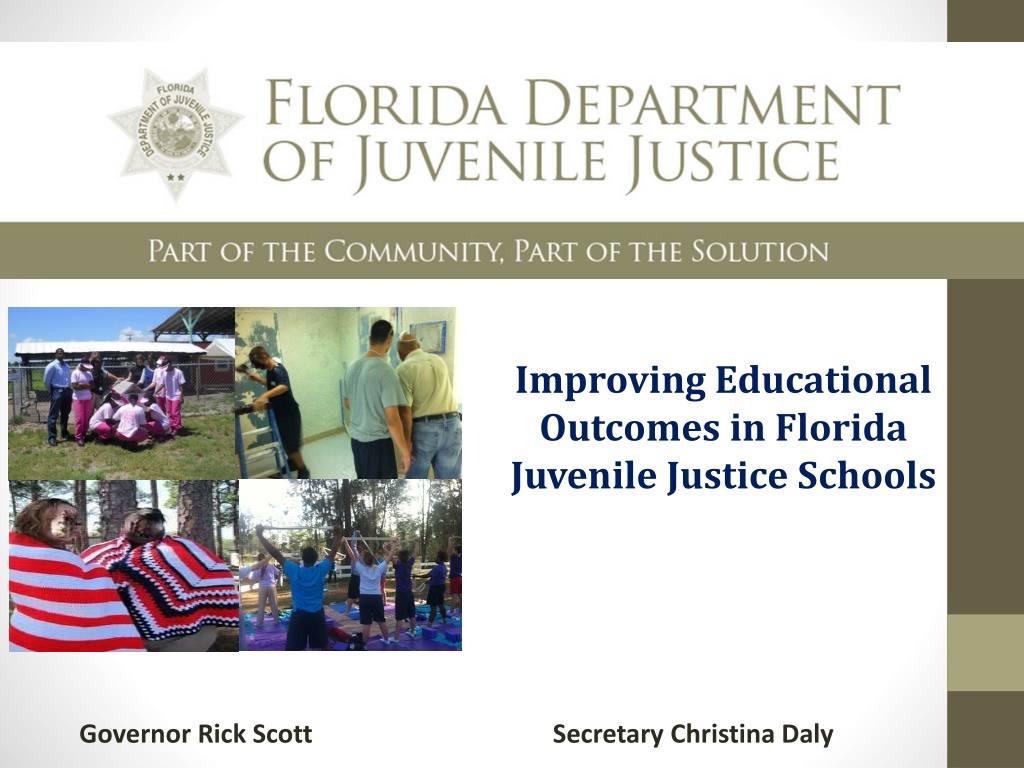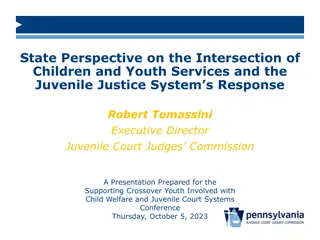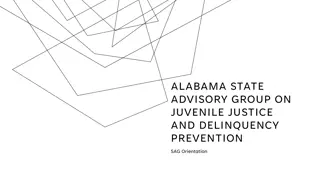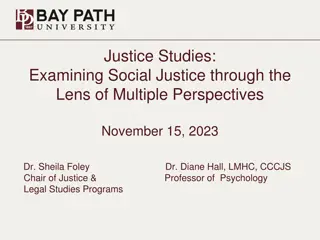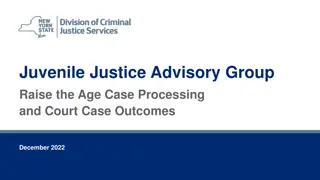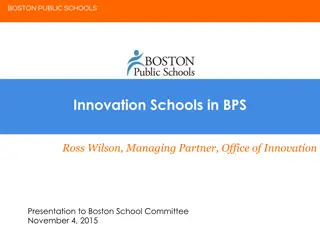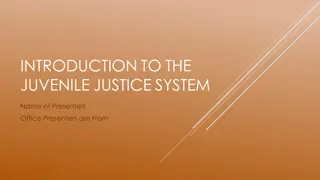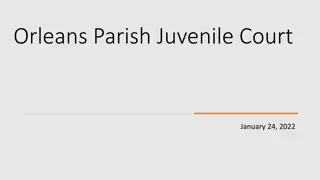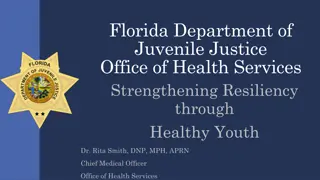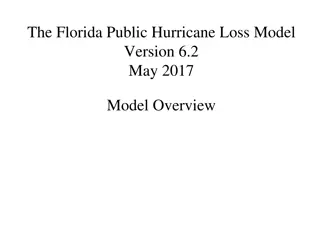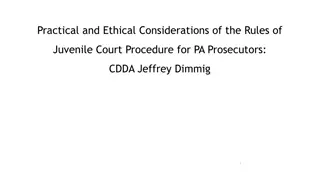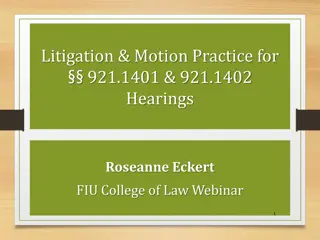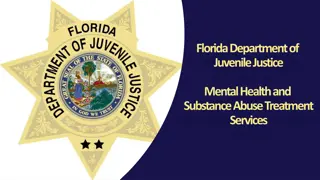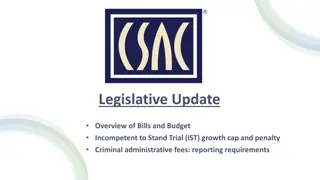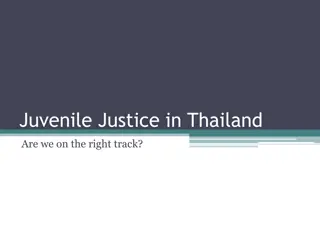Improving Educational Outcomes in Florida Juvenile Justice Schools
This content discusses the evaluation and accountability processes in Florida's Juvenile Justice Schools, focusing on Quality Assurance Reviews, SB 850 provisions, and the need for legislative support. It highlights the roles, responsibilities, and cooperative agreements mandated by Florida Statute 1003.52 to enhance educational services for students under the DJJ jurisdiction.
Download Presentation

Please find below an Image/Link to download the presentation.
The content on the website is provided AS IS for your information and personal use only. It may not be sold, licensed, or shared on other websites without obtaining consent from the author. Download presentation by click this link. If you encounter any issues during the download, it is possible that the publisher has removed the file from their server.
E N D
Presentation Transcript
Improving Educational Outcomes in Florida Juvenile Justice Schools Governor Rick Scott Secretary Christina Daly
Discussion Points Quality Assurance Reviews of DJJ Schools discontinued in 2009-2010 SB 850 DOE/DJJ Accountability and Program Improvement Process 2 Regional Education Coordinator Positions
DJJ School Accountability All DJJ Schools received on site Educational Quality Assurance reviews once per year from The Juvenile Justice Educational Enhancement Program (JJEEP)-funded by Florida Department of Education Evaluation report to School District Superintendent, Principal, and Facility Administrator Recognize high performing DJJ schools Provide technical assistance for low performing DJJ schools Used peer reviews Proviso language added stating educational reviews would occur only if funds were available- reviews ended in 2009 -2010 3 Impetus behind the need for legislation to support the evaluation of DJJ schools
SB 850 Provisions Florida Statute 1003.52 mandates: Roles and Responsibilities Cooperative Agreements Transition Services/Process Accountability Process 4
SB 850 Provisions Florida Statute 1003.52 mandates: Roles and Responsibilities-Districts 3499-(4) Educational services shall be provided at times of the day most appropriate for the juvenile justice program. School programming in juvenile justice detention, prevention, day treatment, and residential programs shall be made available by the local school district during the juvenile justice school year, as provided in s. 1003.01(11). In addition, students in juvenile justice education programs shall have access to courses offered pursuant to ss. 1002.37, 1002.45, and 1003.498. Access to same courses and commensurate resources (Rec. 1.1) 5
SB 850 Provisions Florida Statute 1003.52 mandates: Cooperative Agreements 3712-(14) Each district school board shall negotiate a cooperative agreement with the DJJ on the delivery of educational services to students under the jurisdiction of the DJJ. Such agreement must include, but is not limited to the roles and responsibilities of each agency, including the roles and responsibilities of contract providers. 6
SB 850 Provisions Florida Statute 1003.52 mandates: Transition Services/Process 3576-(10) School districts and juvenile justice education providers shall develop individualized transition plans during the course of a student s stay in a juvenile justice education program to coordinate academic, career and technical, and secondary and postsecondary services that assist the student in successful community reintegration upon release. 7
Florida Statute 1003.52 mandates transition plan collaboration among: personnel in the juvenile justice education program, reentry personnel, personnel from the school district where the student will return, the student, the student s family, and DJJ personnel for committed students. 8
SB 850 Provisions Florida Statute 1003.52 mandates: Transition Services/Process 3602-(10)(b) For the purpose of transition planning and reentry services, representatives from the school district and the one stop center where the student will return shall participate as members of the local DJJ reentry teams. * Also known as Community Reentry Team Meetings 9
Florida Statute 1003.52 mandates: The school district, upon return of a student from a juvenile justice education program, must consider the individual needs and circumstances of the student and the transition plan recommendations when reenrolling a student in a public school. A local school district may not maintain a standardized policy for all students returning from a juvenile justice program but place students based on their needs and their performance in the juvenile justice education program, including any virtual education options. 10
Education Transition Planning in SB 850 Requires school district and One Stop Center representatives where the student will return to participate in CRTs. Requires school districts to consider the individual needs and circumstances of the student and the transition plan recommendations when reenrolling the student. Prohibits school districts from maintaining a standardized policy requiring all students returning from DJJ programs to attend alternative school. Transition should always be based on students needs and performance 11
DOE/DJJ Transition Oversight SB 850 requires agency oversight and guidance for: School Districts Education Providers Reentry Personnel to effectively plan and implement transition services. Transition data including : number and percentage of students who return to alternative school, middle school, or high school upon release and attendance rates before and after participation in juvenile justice education program will be reported to the Legislative by February 1st each year. Rec 2.2 12
SB 850 Section 32. Accountability 3400-Last paragraph in Section 31. The DOE will establish and operate directly or indirectly through a contract, a mechanism to provide accountability measures that annually assesses and evaluates all juvenile justice education programs using student performance data and program performance ratings by type of program. 13
SB 850 Section 32., Section 1003.52, Florida Statutes 3750-(16)(a) The DOE in consultation with the DJJ, district school boards, and providers shall adopt rules establishing: objective and measurable student performance measures to evaluate a student s educational progress while participating in a prevention, day treatment, or residential program. 14
SB 850 http://www.flsenate.gov/Session/Bill/2014/0850/B illText/er/PDF Language referencing DJJ is discussed in lines 3061-3907 through sections 29-32. Status of bill-Signed by Governor Rick Scott in June 2014 15
Adopted Rule February 2015 Rule Title: 6A-6.05281, Educational Programs for Students in Department of Juvenile Justice Detention, Prevention, Residential or Day Treatment Programs. Updated the language to reflect current legislation passed through Senate Bill 850 which was signed into law in June 2014. Contains 9 sections. Areas of emphasis include: Detailed information on student records. Detailed information on student assessments. Extensive services detailing transition. Detailed information on instruction and academic expectations. 16
6A-1.099812, F.A.C. EDUCATION ACCOUNTABILITY FOR DEPARTMENT OF JUVENILE JUSTICE EDUCATION PROGRAMS Content of the laws Content of the rule 17
Rule Authority Section 1003.52(16), F.S., Educational services in Department of Juvenile Justice programs When establishing this rule, the Department of Education must consult with Department of Juvenile Justice District school boards Providers 18
System Requirements Rating must be based on objective and measurable student performance measures that evaluate a student s educational progress Limited to prevention, day treatment and residential programs Measures must be based on appropriate outcomes for all students in juvenile justice education programs Must take into consideration the student s length of stay in the program 19
Measure Requirements Performance measures shall include outcomes that relate to: Student achievement of career education goals Acquisition of employability skills Receipt of a high school diploma or its equivalent Grade advancement The number of CAPE industry certifications earned 20
6A-1.099812, F.A.C. EDUCATION ACCOUNTABILITY FOR DEPARTMENT OF JUVENILE JUSTICE EDUCATION PROGRAMS Content of the laws Content of the rule 21
Sections of Proposed Rule 6A- 1.099812, F.A.C. 1. Purpose of the Rule 2. Definitions 3. Rating Framework 4. Rating System 5. Procedures for Calculating Scores and Ratings 6. Accuracy and Representativeness of Performance Data 22
Section 1 Purpose The purpose of this rule is to implement the performance rating system provided for in Section 1003.52(16)(a) and (b), F.S., for Department of Juvenile Justice Education Programs. 23
Section 2 Definitions Classification score Common assessment DJJ school Designed length of stay Eligible students Exiting students Learning gains Sufficient data Program type 24
Section 3 Rating Framework Three ratings a) b) c) Commendable Acceptable Unsatisfactory 14-day data review period to ensure accuracy of list of schools to be assigned a rating Rating only based on measures for which there are sufficient data 25
Section 4 Rating System Up to 10 components included All are based on a percentage calculation Students must have been in the program for at least 40 days to be included in a measure Additional requirements for some components Methodology for computation of some components may be revised following stakeholder input and review of simulation data 26
1-Common Assessment The percentage of students who make learning gains on the DJJ Common Assessment Based on an exit cohort Only includes students who were in the program for at least 40 days Student must have both a pre- and a post- assessment Learning gain means student increases a level or maintains if already at the highest level 27
2-Learning Gains ELA The percentage of students who make learning gains on ELA assessments Only includes students who were in the program for at least 40 days prior to the assessment Learning gain measurement as defined for traditional school grades Data will not be available for this measure until next year 28
3-Learning Gains -Mathematics The percentage of students who make learning gains on Mathematics assessments Only includes students who were in the program for at least 40 days prior to the assessment Learning gain measurement as defined for traditional school grades Data will not be available for this measure until next year 29
4-Attendance Rate The percentage of students who showing improvement in their attendance rate following re-enrollment Based on an exit cohort Only includes students who were in the program for at least 40 days Must have been enrolled in school prior to and following release from the DJJ school Based on days attended of those enrolled 30
5-Graduation Rate The percentage of students whose last school attended was a DJJ school who graduated or earned a GED within 5 years of entering 9th grade Based on a 9th grade entry cohort Only includes students who were in the program for at least 40 days DJJ school must have been the last school they attended 31
6-Certified Teachers The percentage of core courses taught by teachers certified for the subject area Only includes core courses as identified by the Course Code Directory 32
7-Data Integrity The percentage of students who have pre- and post-test data on the common assessment Based on an exit cohort Only includes students who were in the program for at least 40 days 33
8-Postsecondary Enrollment The percentage of students attending postsecondary institutions Based on an exit cohort Only includes students who were in the program for at least 40 days Only includes students with a diploma or GED at the time of exit Enrollment can be anytime within one year of exit 34
9-Employment The percentage of students employed Based on an exit cohort Only includes students who were in the program for at least 40 days Only includes students who were at least 16 at the time of release and not attending a post-secondary institution Employment can be anytime within one year of exit 35
10-CAPE The percentage of students who earn a CAPE Industry Certification (High School) or Digital Learning Tools (Middle School) Certificate Only applies to programs with a designed LOS of 9 months or longer Based on an exit cohort Only includes students who were in the program for at least 40 days Certificate can be earned anytime within one year of exit 36
Section 5 -Procedures for Calculating Scores and Ratings Three proposed ratings include Commendable, Acceptable and Unsatisfactory Components will be rated on a 3-point scale Cut points for the individual components will be approved by the State Board following recommendations by the Commissioner based on simulation data and input from stakeholders Rating will be the simple average of the components with sufficient data, rounded to the nearest whole number If a DJJ school doesn t have sufficient data to generate a rating for three years in a row, the prior three years of data will be aggregated to produce a rating 37
Section 6 Accuracy and Representativeness of Data Superintendents shall appoint a DJJ accountability contact in each district Contact must work with DJJ to ensure data are accurately reported, and that the DJJ school is appropriately classified Describes conditions for withholding a rating or awarding an Incomplete rating Describes provisions for review and appeal of rating 38
Use of Outcome Data Evaluate each Juvenile Justice School in Florida Share outcome data with state legislature and governor through reports Use to determine which schools receive on-site reviews Use to pair mentor/mentee sites for improvement Use to showcase best practices Share with facility treatment staff, possible use within mutual accountability teams Share with School Justice Partnerships Rec 2.2 39
New Education Positions Legislature provided DJJ funding for 4 regional educational positions Education Coordinators support all DJJ education programs and transition functions Serve on Quality Improvement reviews Facilitate on site education review process for next school year based on outcome data 40 Coordinate data review teams
Implementation Status FDOE is collecting public input on proposed rule Anticipate State Board of Education approval in January 2016 Drafting additional program improvement rule Success Buy in from providers and districts Committee will review sample data prior to State Board approval Challenges Time to develop rule Concern that some measures hold DJJ schools accountable for things outside their control 41
Contact Information Julie Orange, Director of Education 850 717-2708 Julie.Orange@djj.state.fl.us 42
